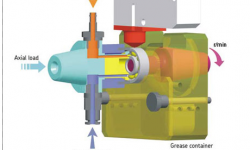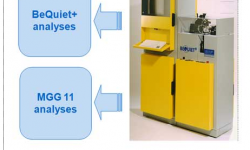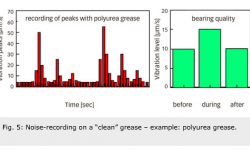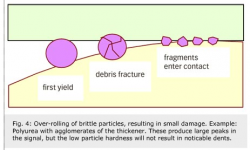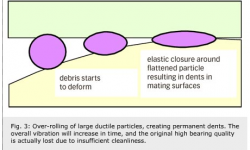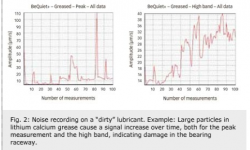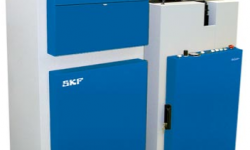
Testing grease noise in rolling bearings
Noise is a key parameter in the assessment of grease quality. Because lubrication is so vital to bearing performance, SKF is an active developer of testing equipment for noise measurement of greases. The latest equipment on the market is the SKF Grease Test Rig BeQuiet+.
Developments by SKF in the field of noise-testing equipment for greases are based on customer needs for extended bearing service life and low-noise performance. To verify that the required cleanliness level and lubrication conditions are fulfilled requires a rigorous testing system and the SKF Grease Test Rig BeQuiet+ enables assessment of lubricant quality with regard to cleanliness and damping characteristics.
Over the years, SKF has developed a number of grease-testing machines, in order to deepen its own understanding of lubrication theory. This has supported SKF’s standing in the market, not only as a leading bearing manufacturer, but also as a main grease supplier. The SKF Quality Technology Centre in Steyr, Austria, is responsible for the development, manufacturing and sales for grease-testing machines. The development carried out there has been accomplished in close cooperation with SKF ERC, the SKF Engineering & Research Centre based in the Netherlands.
SKF is the market leader in grease-testing technology. The technique has been enhanced through tribology research for many years and successfully industrialized for years by SKF. The company’s BeQuiet grease noise tester has been so successful that it has become the standard equipment for grease noise testing within the lubricant industry.
In the industry, the grease-testing rig is recommended as a tool for lubricant manufacturers in development activities and for production control. Bearing producers can use the test machine as a means to select the best lubricant on the market, and for incoming batch control an end user can verify the lubrication quality in service.
Importance ofclean lubricant
SKF’s bearing life theory underlines the use of clean lubricants for rolling bearings as essential for obtaining a long bearing service life. In the case of grease lubrication, many factors can affect the degree of cleanliness during operation, but a clean grease for the initial lubrication, as well as for relubrication, is always required. Also, in applications where the bearing fatigue life is not at stake (e.g., because of very light loads), the need for clean grease can still be extremely important, for example contributing to low bearing noise, which is required for applications such as electric motors, fans, etc.
In the field, for example, fan bearings are expected to run extremely quietly. It is clear that electric motor manufacturers require bearings with the lowest possible vibration level and absence of disturbing noise. This calls for an extremely clean, low-noise grease.
Bearings in automotive gearboxes are expected to last as long as the vehicle. Such bearings are exposed to foreign matter in the gear oil, often originating from the gears. This adversely affects the bearings. The particles being over-rolled damage the raceways, producing “dents” and raising the stress level at their edges, which promotes an ageing process, leading to surface distress. This in turn leads to increased noise and finally to bearing fatigue failure.
How noise is generated
Since the film thickness that separ-ates the mating surfaces in the rolling contact is very thin (usually below one micron), it is clear that any particles in size larger than the film thickness can disturb the smooth running. se bild . 2 shows a recording of the vibration peaks of an unclean lubricant. The vibration peaks are recorded by filtering the short duration effect of the over-rolling of particles from the total signal. The over-rolling of larger ductile particles can lead to permanent dents of the raceways (se bild . 3). If that occurs, the overall signal will increase in time, indicating that the original high bearing quality is actually lost by the use of a lubricant with insufficient cleanliness. The over-rolling of brittle particles creates small damage of the bearing surface (se bild . 4).
Experience has made it clear that particle over-rolling can be split into four distinct quality classes: dirty, noisy, clean and quiet. This classification can be defined as follows:
Dirty
The hardness and size of particles is such that over-rolling leads to a permanent damage in the contact surfaces, resulting in increased overall noise and reduced bearing service life.
Noisy
The hardness and size of over-rolled particles may damage the bearing contact surfaces, which leads to a noticeable increase in overall bearing noise level, but not to the degree that the bearing ser-vice life is adversely affected.
Clean
The hardness and size of over-rolled particles will produce noticeable vibration peaks, but there is no permanent damage of the bearing contact surfaces.
Quiet
The highest degree of cleanliness, this is due to a minimum of particles that produce vibration peaks.
Lubricants of the “dirty” class are rare in the delivery condition, but due to the application situation this condition may develop in operation.
There are a few greases on the market that fall into the class “noisy”, due to their thickener type or the inclusion of solid additives. Typical examples are some calcium-complex greases that contain large particles of calcium salts, which produce small permanent dents (se bild . 3).
The majority of today’s greases falls in the class “clean”. Typical examples are polyurea greases, where large agglomerates of the thickener can be present. These greases can produce large vibration peaks, but since the hardness of these particles is low, the over-rolling will not give noticeable dents (se bild . 5).
Only a few greases can be classified as “quiet”. Typical examples are lithium-soap greases that are produced in a clean environment and by a process that filters out undue particles and produces a fine soap structure.
The purpose of the new SKF Grease Test Rig BeQuiet+ is to determine the grease quality in these levels in order to develop, improve or identify quiet greases. Comparison of the damping characteristics of different lubricants should be made on the same bearing, mounted in an identical manner. When all these precautions are taken into account the selection of the lubricant with optimum damping characteristics can be made successfully.
Many factors within the lubricant are found to contribute to the damping characteristics. For oils, the important factors are the viscosity, the base oil type and the applied additive types. A clear trend of increased damping at increased oil viscosity can often be found (se bild . 6). For greases, the damping characteristics can be quite erratic, probably also because the type of thickener and its microstructure will play a role. Moreover, additives influen-cing wettability with strong surface attack can become dominant.
The SKF Grease Test Rig BeQuiet+ enables lubricant producers to develop lubricants with highest damping characteristics. For the bearing manufacturers this tool is equally important for selecting, e.g., grease with highest damping characteristics.
Measurement procedures
The measurement procedure of the SKF Grease Test Rig BeQuiet+ has been laid down in international standards, such as ISO standard 15242 and ANSI/ABMA standard 13-1987.
These standards define suitable frequency bands and other boundary conditions for noise quality evaluation of greases. The bearing inner ring rotates at 1,800 r/min; a velocity sensor at the (non-rotary) outer ring measures the radial movement of the outer ring.
The software filters out three frequency ranges (low, medium, high) from the measured vibration signal. Experience has shown that the low range essentially contains only noise from the bearing itself. For this reason only the medium and high band ranges are used to evaluate the noise behaviour of grease. The obtained signal is mathematically filtered and then analyzed according to the SKF BeQuiet+ measuring method and/or the MGG 11 evaluation method.
BeQuiet+ measurement method
The advantage of the SKF BeQuiet+ measurement method is the unique test procedure and degree of automation. The full automatic procedure consists of repetitive dosing of the lubricant to the test bearing and recording of the vibration level and peaks. This procedure avoids ingress of dirt particles from the environment that otherwise can disturb the measurement results and makes it possible to use the same bearing for different tests without the necessity of dismounting. This can be advantageous for determining the “damaging” characteristics of dirty lubricants by following a sequence of first testing a reference lubricant, then a lubricant and then again the reference lubricant.
The key component of the rig is the proprietary SKF Peak Detection Algorithm, which enables these vibration peaks to be singled out from the total bearing vibration signal. The intensity of the peaks detected is used to assess the quiet running behaviour in a quantitative way. The user is then able to compare the result with a definable target.
MGG 11 measurement method
Selected 608 deep groove ball bearings are cleaned and conserved in calibration oil. Their noise behaviour is identified and kept as reference value. This corresponds to the real world situation: At the end of the production process, bearings are first conserved and then lubricated.
After the reference state has been determined, the bearings are lubricated and their noise behaviour is tested.
The measurements are pro-cessed and the noise class is determined by the MGG 11 algorithm running on the SKF Grease Test Rig BeQuiet+. The results describe noise class and start-up behaviour. This enables a finely grained classification of the tested lubricating grease. The MGG 11 test method offers valuable details about the quality and homogeneity of a grease to producers and customers, for the development of new greases as well as routine checks. Furthermore, the long-term behaviour of lubricating greases and conservation oils and their compatibility can be investigated by exposure tests.
With the new BeQuiet+ software, the evaluation of grease noise testing according to SKF and the MGG 11 specifications can be done on a single system. It combines the advantages of the two systems. The system measures the following grease parameters essential for a bearing application:
-
quiet running classification of lubricants in terms of particle over-rolling
-
determination of permanent bearing damage due to lubricant
-
lubricant damping characteristics
-
grease start-up behaviour
-
constant running noise of grease
-
noise peaks for medium- and high-band
-
comparison of lubricants with regard to their damping characteristics.
In addition to the SKF Grease Test Rig BeQuiet+, SKF offers a complete product series for the lubricant industry to make sure that bearing systems have no excuse for not running quietly and having a long operational life.
SKF grease testers: a complete product series for the lubricant industry
- SKF Grease Test Rig BeQuiet+: noise testing
-
SKF Grease Test Rig R0F+: life-span test stand
-
SKF Grease Test Rig RHF1: life-span test stand for high-speed applications
-
SKF Grease Test Rig EMCOR: test stand for corrosion resistance (standardized)
-
SKF Grease Test Rig V2F: test stand for axle bearings of railway
vehicles (standardized) -
SKF Grease Test Rig R2F: test stand for the mechan-ical-dynamic behaviour
-
SKF Grease Test Rig RST: test stand for the shearing strength of grease (standardized)


